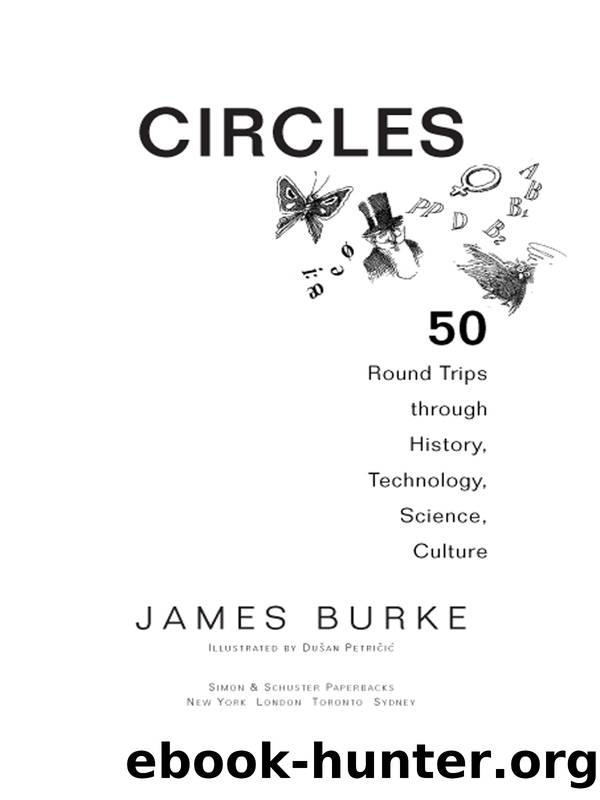Circles by James Burke

Author:James Burke
Language: eng
Format: epub
Publisher: Simon & Schuster
Published: 2000-04-15T00:00:00+00:00
26
TURKISH
DELIGHT
I WAS WATCHING TV one chilly evening recently and thinking about sun, sand, sea, and stuff when suddenly on the screen there was an ad extolling the tourist and cultural attractions of one of my favorite holiday spots: Turkey. One bit of the screen showed the tulip (almost the Turkish national emblem) and the other, the ruins of ancient Troy, the city that a German weirdo called Heinrich Schliemann âfoundâ in 1872.
Schliemann was a self-made businessman whoâd made a fortune in the California goldfields and then by marketing dyestuffs in Russia. At one point he became obsessed by the writings of Homer and decided to spend a fortune trying to prove that the Iliad, and Troy, and all that poetic rambling about Helen launching a thousand ships, had all really happened. He failed, but his work was to stimulate real archeologists to take a closer look, later on. Meanwhile, Schliemannâs sidekick in these efforts was a medical genius (and fellow Homer freak) named Rudolph Virchow, known from his imperious mein as the âPope of German Medicine,â who, apart from anything else, virtually kicked off public health and is celebrated as the discoverer of cellular pathology.
It was Virchow who made the momentous statement that was to change medicine: Omnis cellula a cellula (all cells come from other cells). By identifying the cell as the ultimate unit of life and disease, Virchow also paved the way for chemotherapy. For all these reasons, Virchow provided Schliemann with what that egregious, bad-tempered conman and thief desperately needed: an aura of scientific respectability. But Virchow was also in Troy for his own reasons. He was an amateur anthropologist, and interested in the history of human culture.
Anthropology had been more or less invented in Germany by Johann Blumenbach, who, among other things, related skull shape to racial classification. He did so by placing a skull between his feet and looking down at it. This became known among his adherents as the âBlumenbach position.â Using it, Blumenbach divided humans into five racial groups, to which he gave names, one of which is still in relatively general use: âCaucasian.â In 1724 Blumenbach was asked to investigate the case of the âSavage Boy,â an orphan child discovered in Hanover and said to be a living example of a prehistoric human. Blumenbach eventually demolished this argument, but not before the boy had been sent to London where he was cared for (and exhibited, and much discussed among philosophers) by the queenâs physician, a gent Iâve mentioned elsewhere, Dr. John Arbuthnot, whose work on statistical probability galvanized a dull Dutchman called Williamâs Gravesende.
In 1736 this person (whose life is described even by ardent biographers as âuneventfulâ) was teaching Newtonian science in Leyden University and had a visit from a Frenchman engaged in writing a general guide to the great English physicistâs work. Thanks perhaps to âsGravesendeâs advice, the Frenchmanâs book would make its author the most famous science writer in Europe. His name was Voltaire.
As it happens, Voltaire also knew Arbuthnot,
Download
This site does not store any files on its server. We only index and link to content provided by other sites. Please contact the content providers to delete copyright contents if any and email us, we'll remove relevant links or contents immediately.
Learning SQL by Alan Beaulieu(6235)
Weapons of Math Destruction by Cathy O'Neil(6204)
Digital Minimalism by Cal Newport;(5696)
iGen by Jean M. Twenge(5384)
Sapiens by Yuval Noah Harari(5320)
The Age of Surveillance Capitalism by Shoshana Zuboff(4240)
Elon Musk by Ashlee Vance(4081)
Thing Explainer by Randall Munroe(3904)
Apollo 8 by Jeffrey Kluger(3664)
Future Crimes by Marc Goodman(3558)
The Science Book (Big Ideas Simply Explained) by DK(3249)
Who Can You Trust? by Rachel Botsman(3109)
The Innovators: How a Group of Hackers, Geniuses, and Geeks Created the Digital Revolution by Walter Isaacson(2973)
I Live in the Future & Here's How It Works by Nick Bilton(2957)
Infinite Energy Technologies by Finley Eversole(2951)
Steve Jobs by Walter Isaacson(2854)
Dawn of the New Everything by Jaron Lanier(2751)
Chernobyl by Serhii Plokhy(2514)
Ben Franklin's Almanac by Candace Fleming(2492)
